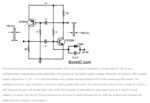neazoi
Advanced Member level 6
I have found this circuit on the net. I wonder
1. What the sync does and with what signal to drive it (eg. a negative pulse in the sync produces a single pule on the outputs? or what?)
2. What frequency should I expect with 100ns pulse width? I am not talking about the differential pulses repetition rate, I mean a single 100ns pulse, assuming it is repeated every 100ns (which is not in that case).
3. Starting values for C?
1. What the sync does and with what signal to drive it (eg. a negative pulse in the sync produces a single pule on the outputs? or what?)
2. What frequency should I expect with 100ns pulse width? I am not talking about the differential pulses repetition rate, I mean a single 100ns pulse, assuming it is repeated every 100ns (which is not in that case).
3. Starting values for C?
